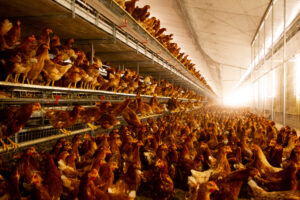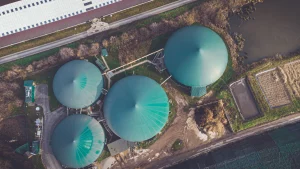Report: A Surge of Farm Waste Vulnerable to Flooding
As the region digs out of back-to-back storms, locals are contending with a toxic and growing problem: animal waste from factory farms. (Image: Adobe)
(Image: Adobe)
In recent years, Southern states like Georgia and the Carolinas have seen an explosion in the number of poultry and swine concentrated animal feeding operations (CAFOs), commonly called factory farms. As a result, millions of animals, piles of manure and fertilizer-laden fields were lying in wait directly in the path of Hurricane Helene — one of the most destructive storms these states have ever seen.
The CAFOs of North Carolina were the largest ticking time bombs in Helene’s 350-mile-wide path of destruction. From 2007 to 2022, poultry CAFOs there surged by more than 40%, according to a new report from the Environmental Working Group. Today, the state is home to 4,863 poultry farms that house some 357 million chickens and turkeys that generate more than 3.2 million tons of waste annually (about the weight of 970,000 Tesla Cybertrucks, in case you were wondering).
The manure that builds up on CAFOs — often in piles 8 feet or higher — is a known source of chemical pollution. Even on a good day, these pollutants leach into drinking water and drift on the air into neighboring communities. At least 156 of these farms can be found on or beside floodplains; many more are in vulnerable areas.

“The rapid growth of the industry there and the resulting dense concentration of poultry operations should raise alarm bells about residents’ health, drinking water and air quality,” said EWG analyst Al Rabine.
Western North Carolina got the worst of Helene. It also happens to be where some of the state’s recent CAFO growth has been concentrated. The storm pummeled the region with as much as 14 inches of rain in just three days. Farms lost power for ventilation and feeding machines, at least two poultry processing plants in North Carolina and Georgia were shut down, and 1,021 poultry barns that house almost 21.6 million birds were inundated.
“Poultry farming … is a lightly regulated and secretive enterprise.”
The rising water that tore through neighborhoods and swept away homes undoubtedly carried nitrogen, phosphorus and ammonia, as well as giardia and E. coli and salmonella. But locals can’t know for sure, because the industry operates in the shadows, thanks to a general statute that forbids the Department of Agriculture from disclosing information about individual farms. To make its own count of farms and animals, the EWG used aerial imagery and AI recognition techniques.
“Poultry farming, the backbone of North Carolina’s largest agriculture sector, is a lightly regulated and secretive enterprise,” reports the Charlotte Observer.
This is not the Tar Heels State’s first brush with hurricane-borne animal waste. Hurricanes Floyd in 1999 and Matthew in 2016 flooded lagoons, hog and poultry barns, and thousands of acres of fields oversaturated with manure, according to Food and Water Watch. And after Hurricane Florence in 2018, private water wells saw major spikes in E. coli and fecal matter contamination.
Amid all the concerns and tragedies that have piled on residents since Helene, watchdogs and activists have warned about the dangers of flood-related runoff from thousands of CAFOs, but specific information is sparse.
“Our state agencies are not only lax with regulating these facilities, but they do not know where or how many currently exist,” states the advocacy group, Clean Water for North Carolina.
Your support is crucial…With an uncertain future and a new administration casting doubt on press freedoms, the danger is clear: The truth is at risk.
Now is the time to give. Your tax-deductible support allows us to dig deeper, delivering fearless investigative reporting and analysis that exposes what’s really happening — without compromise.
Stand with our courageous journalists. Donate today to protect a free press, uphold democracy and unearth untold stories.


You need to be a supporter to comment.
There are currently no responses to this article.
Be the first to respond.